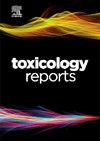Major toxin composition of particulate matter from a coal-fired power plant and its proteomics-associated toxicological profiles in the lungs of balb/c mice
Q1 Environmental Science
引用次数: 0
Abstract
This comprehensive study investigated fly ash particulate matter (PM) from Thailand's Mae Moh Coal-fired Power Plant, focusing on its major toxin composition and toxicological effects in mice. Chemical composition analysis using inductively coupled plasma-mass spectrometry identified iron (Fe) as the predominant heavy metal (101,067.31 ± 8246.12 mg/kg). Meanwhile, gas chromatography-mass spectrometry showed acenaphthene as the most abundant polycyclic aromatic hydrocarbon (40.77 ± 0.003 mg/kg). Toxicological profiling was conducted on Balb/c mice via intratracheal instillation at doses of 1 and 10 mg/kg/day for 7 days, with comparisons made to a vehicle negative control and standard PM2.5 as a positive control. Both fly ash PM and standard PM2.5 induced pulmonary inflammation, evidenced by the presence of neutrophils in peribronchial and perivascular areas. Dose-dependent increases in interstitial edema and alveolar macrophages were also observed. Proteomic analysis revealed three inflammation-associated pathways, including leukocyte transendothelial migration, neutrophil extracellular trap formation, and phagosome activity. The increase in pulmonary inflammation may contribute to the pathogenesis of various chronic diseases and promotion of lung cancer. These findings provide valuable insights for academic researchers, electricity enterprises, and policymakers in developing effective strategies to manage air pollution worldwide.

燃煤电厂颗粒物的主要毒素成分及其在balb/c小鼠肺中的蛋白质组学相关毒理学特征
这项综合研究调查了来自泰国Mae Moh燃煤电厂的粉煤灰颗粒物(PM),重点研究了其主要毒素成分和对小鼠的毒理学影响。化学成分分析采用电感耦合等离子体质谱法鉴定铁(Fe)为主要重金属(101,067.31 ± 8246.12 mg/kg)。同时,气相色谱-质谱分析表明,苊是含量最高的多环芳烃(40.77 ± 0.003 mg/kg)。以1和10 mg/kg/天为剂量,通过气管内滴注Balb/c小鼠,连续7天进行毒理学分析,并与车辆阴性对照和标准PM2.5阳性对照进行比较。粉煤灰PM和标准PM2.5均可引起肺部炎症,支气管周围和血管周围存在中性粒细胞。还观察到间质水肿和肺泡巨噬细胞的剂量依赖性增加。蛋白质组学分析揭示了三种炎症相关途径,包括白细胞跨内皮迁移、中性粒细胞胞外陷阱形成和吞噬体活性。肺部炎症的增加可能参与各种慢性疾病的发病机制,促进肺癌的发生。这些发现为学术研究人员、电力企业和政策制定者制定有效的全球空气污染管理策略提供了宝贵的见解。
本文章由计算机程序翻译,如有差异,请以英文原文为准。
求助全文
约1分钟内获得全文
求助全文
来源期刊

Toxicology Reports
Environmental Science-Health, Toxicology and Mutagenesis
CiteScore
7.60
自引率
0.00%
发文量
228
审稿时长
11 weeks
 求助内容:
求助内容: 应助结果提醒方式:
应助结果提醒方式:


